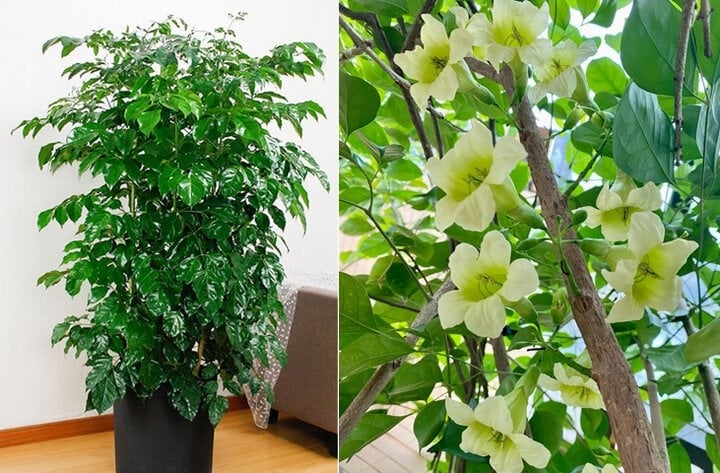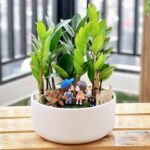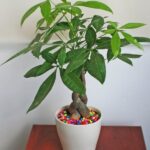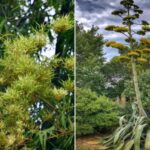Golden Money Tree
The Golden Money Tree is often grown indoors and in offices not only for its aesthetic appeal but also for its Feng Shui significance. With its lush green branches and leaves all year round, the tree serves both decorative and air-purifying purposes and is considered a symbol of luck and prosperity.
Despite its popularity, not many know that the Golden Money Tree can bloom. In fact, when provided with ample sunlight, the tree can flower and even bear fruit. However, when grown indoors with insufficient light, it often loses this ability. The flowers are white and usually bloom during the summer months.
Many believe that the blooming of the tree brings good fortune to its owner. To encourage flowering, one must create suitable growing conditions, provide frequent diluted fertilizer, and maintain moderate watering, only when the soil is 40-50% dry. During the flowering period, from May to November, it is recommended to fertilize with phosphorous and potassium once every half a month to stimulate blooming.
Lucky Tree
The Lucky Tree is a popular houseplant, featuring small, shiny green leaves that are pleasing to the eye. Beyond its symbolic meaning, the tree is also known for its air-purifying abilities, making it a common choice for indoor spaces.

The Lucky Tree boasts small, shiny green leaves.
While it rarely flowers, the appearance of blooms is considered a symbol of good luck and fortune. The flowers of the Lucky Tree are relatively large, growing in bell-shaped clusters and emitting a pleasant fragrance. The flowering period typically occurs during the summer and autumn months, lasting for about 2-3 months each time.
The longer you nurture the Lucky Tree, the higher the chances of it flowering. To encourage blooms, it is advisable to plant it outdoors, ensuring ample sunlight and good ventilation. Fertilizing with a multi-element mixture at least twice a month will support the tree’s growth and flowering potential. Additionally, regulating the amount of water is crucial; withholding water temporarily can stimulate flower bud differentiation.
Money Plant
The Money Plant is a perennial herb with thick, lush leaves that resemble a stack of coins. Aside from its decorative appeal, this plant effectively absorbs pollutants such as benzene, toluene, xylene, and ethylbenzene from the air, contributing to a cleaner environment.
While primarily admired for its foliage, the Money Plant can also bloom. The flowering season typically occurs during winter and spring, and many believe that the plant’s flowering foretells good fortune. To encourage blooming, regular fertilization is key. Twice to thrice a month, apply a mixture of 0.2% urea and 0.1% dipotassium phosphate.
This plant thrives in sunlight, so placing it near a window is ideal. Maintain regular watering and repot the plant every six months to stimulate root growth, enhancing its ability to flower.
Sago Palm
The Sago Palm is a tropical plant often grown in large pots to adorn living spaces. It is a challenging plant to induce flowering, and even when it does, it may only occur once every few years. However, when the Sago Palm does bloom, it is a cause for celebration, signaling the arrival of positive and lucky events.
When provided with optimal conditions and proper care, the Sago Palm can not only flower but also bear fruit. The fruits, known as “golden eggs,” are round and symbolic of wealth and prosperity. The flowers are large and ivory-hued, resembling a jar of gold. As a tropical plant, the Sago Palm favors warm temperatures and ample sunlight. In suitable environments with good lighting, the plant is more likely to develop buds and bloom compared to colder regions. Therefore, ensuring sufficient light is crucial for its flowering process.
Jade Plant
The Jade Plant is a succulent commonly grown as a houseplant. It is easy to cultivate, can be propagated by leaf cuttings, and grows rapidly. However, inducing flowering is a different story. The flowers of the Jade Plant are considered a symbol of good luck and fortune. They boast a beautiful purple hue, making them ideal for indoor decoration as well.
To encourage the Jade Plant to flower, ensure it receives ample outdoor sunlight, and allow it to mature for at least five years. Additionally, fertilize the plant regularly; every ten days, dilute potassium hydroxide with water and apply it directly to the roots to stimulate early and attractive blooming.
The Ultimate Guide to Feng Shui Trees for Wood Element: Enhancing Your Home, Your Style, and Inviting Prosperity
Are you a believer in the power of Feng Shui and seeking plants that will bring good fortune and prosperity? Do you wish to transform your living space into a vibrant and refreshing oasis? Then look no further than these carefully curated Feng Shui plants that are sure to bring positive energy and harmony to your home or office.



































